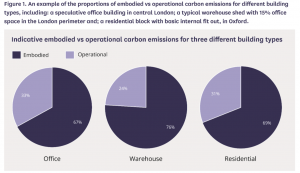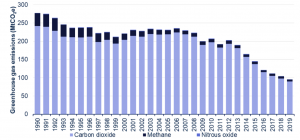Dr Aidan Bell, founder, EnviroBuild, dissects the Planning for the Future: Planning policy changes in England in 2020 and future reforms
You could be mistaken for missing February’s House of Commons research briefing on “Planning for the Future: planning policy changes in England in 2020 and future reforms” (PFTF). The review of the Robert Jenrick’s (the then Housing Minister’s) self-proclaimed “once in a generation” planning reform was released in the brief gap between Covid fading into endemic status and Russia invading Ukraine.
The need to increase housing supply is a universal truth, with all the main political parties committing to building more houses in their 2019 election manifestos. According to the National Housing Federation, 340,000 new homes need to be built every year to meet current demand in England.
The planning proposals were summarised on PBC today at the time, including ensuring up-to-date local plans for all LPAs, a higher threshold for the Housing Delivery Test and easier conversion of commercial to residential buildings. It remains to be seen how the last two points will conflict with the other aim of a more consultative grass-roots implementation.
Section 106 negotiations
A particularly welcome feature is the introduction of a national levy for developer contributions. The current system of Section 106 agreements involves months of negotiations and what has been described as the “dark art” of viability discussions. Viability assessments are a carefully and precisely honed art carried out by consultants who are regularly compensated based on their success in reducing the number of affordable units required to be built. The calculation of viability includes determining residual land value, agreeing on acceptable levels of profit and quantifying predicted sales values based on “comparable” developments. The assessments are made using vaguely defined inputs thereby allowing for calculations to be engineered by developers and then subject to months of negotiations.
Speaking to the House of Lords Built Environment Committee, Christopher Pincher, MP described Section 106 as a “rather slow and opaque mechanism for the provision of affordable homes and other necessary infrastructure to complement house building”. As a result, “it often means that the infrastructure development comes much later than the council and the community expected [and] that the infrastructure that comes is not quite what they expected because elements of it are negotiated away”.
This system is to be replaced with a nationally-set, value-based flat rate or rates, with an offset for any affordable housing provided. This new levy will provide a defined mechanism to help to prevent further manipulation of the well-intentioned, but previously flawed system. Pincher hopes that this new infrastructure levy will prove to be “up front and very clear” in order to “put more ammunition into the hands of local authorities”
Reducing the carbon impact of buildings
Two deliberate omissions from PFTF are the topics of embodied carbon and the performance gap. In fact, in its response to The Future Homes Standard 2019 Consultation on changes to Part L and Part F of the Building Regulations for new dwellings, the government stated that these subjects are beyond the scope of consideration.

Despite the government’s response, the matter of embodied carbon is becoming increasingly important. The Government’s own report, Reducing the whole life carbon impact of buildings, shows that in a standard Oxford Residential flat the embodied carbon is accounted for 69% of the total carbon. As buildings become more efficient and the electrical grid becomes greener with an increasing supply of clean energy, the importance of addressing embodied carbon will continue to grow.

A solitary focus on reducing operational carbon rather than the aggregate of embodied and operational carbon addresses well under half of the impact of a building and is clearly short-sighted. No legislation appears to be on the horizon, and it is unlikely the private sector will act fast on its own.
Furthermore, this focus on operational carbon can lead to suboptimal outcomes. For example, triple glazed windows are preferable to double glazed windows in operational carbon terms, but not in embodied carbon. When considering the aggregate carbon footprint of double and triple glazed windows, it is estimated that the former outperforms the latter for the first 20 years of use. As the electrical grid continues to decarbonise, this timeframe will extend even further in the future and potentially even become a worse outcome.
In addition to the non-inclusion of embodied carbon, the Planning for the Future proposal also does not account for a performance gap in its calculations of carbon reductions, which is the difference between the expected and actual operational carbon use within a building. It is estimated that buildings consume 2-10 times more energy than predicted at design stage.
The proposals of the Housing and Net Zero build on the 2017 Clean Growth Strategy are both reviewed in PFTF. The Clean Growth Strategy had aimed to introduce regulations by 2020 lowering new build emission by 21 or 30% and by 75-80% in 2025.
No legislation has yet been delivered on either of these targets. Instead PFTF waters this down significantly to “Facilitate ambitious improvements in the energy efficiency standards for buildings to help deliver our world-leading commitment to net-zero by 2050”.
We have been here before. The UK is currently behind on its 4th and 5th carbon budgets, having primarily succeeded in hitting the previous two through an incredible success story of decarbonising the grid.
The Code for Sustainable Homes (CSH)
Launched by the Labour government in 2007, the CSH was initially a voluntary national standard that set out a framework for the home building industry to design and construct homes to higher environmental standards.
At that point there was approximately 383ppm of CO2 in the atmosphere. The Interntional Panel for Climate Change estimates that to keep the global temperature increase to 1.5०C above pre-industrial levels (a point at which 70-90% of warm water coral is still expected to die) the amount of CO2 in the atmosphere should not exceed 430ppm.
The ambitious CSH legislated that all new build homes would be carbon neutral by 2016. Under the austere Tory coalition government timelines slipped until the CSHs was scrapped entirely in 2014 as part of their “bonfire on red tape”.
The result is, 15-years after launch the world-leading CSH targets have been replaced with a proposal that doesn’t yet contain enough detail to make a proper judgement. The language used in the proposal is vague, leaving much room for interpretation and watering down. With no quantifiable measures against which performance can be judged, the effectiveness of the proposal as it is cannot yet be determined, but it doesn’t look particularly hopeful.
Unfortunately whilst we have procrastinated and dithered, the concentration of CO2 in the atmosphere has steadily risen from 383ppm in 2007 to 419ppm, utilising 76% of the available headroom that we had. It is entirely possible that in the time it takes to draft and pass the legislation that any homes built to the forthcoming new standard, the 430ppm threshold will already be exceeded.
Criticism has also been made that not enough is done to retrofit existing homes. There is a target of achieving an EPC level C for all fuel poor housesholds by 2030 and for all households by 2035. I assume that the ECO4 funding (required from April 2022) will be given parliamentary approval, in spite of rising energy bills. More attention and money should be spent upon retrofits, but that’s another article.
Big changes can only be created through Government action, where the private sector inevitably aims for profit, and too often a race to the bottom in standards – positive change requires legislation. The climate crisis is one of the greatest challenges the world faces. The glacial pace of change is a choice, and one causing irreconcilable damage to our ecosystems.
Government working at a glacial pace and blaming their inefficiency on bureaucracy and “red tape” is no longer acceptable. We’ve now seen what government achieved with Covid as a motivating force. We know that the government managed to find the elusive magic money tree when it was required. That gives me some hope that eventually we’ll prioritise the preservation of a reasonably habitable planet for future generations
However, time is of the essence. By the time the proposal for a new sustainable standard is drafted, debated and gains royal ascent, will it be going far enough?
As with all policy decisions, a view of the bigger picture is necessary for developing integrated and cohesive policies. Collaboration across agendas (sustainability, social housing, transport, economic viability etc.) is required to effectively plan for the future. In her response to Planning for the Future, Victoria Hills, Chief executive of the RTPI voiced her concern about a potential lack of integrated planning in stating that, “without proper planning, developers will be given carte blanche to build in places which perpetuate car dependency and health-sapping deprivation”. It is imperative that government bodies and homebuilders work in close partnership to develop the built environment in a considered fashion.

Medium and high density buildings benefit from higher energy efficiency. Houses built in areas with good transport links, even on top of train stations, relieve the pressure on roads and reduce the carbon footprint from transport. Building on brownfield sites helps to protect green belt land whilst alleviating the housing shortage. These types of buildings should be prioritised for their merits in addressing a broad range of issues, beyond just sustainability.
Those with an interest in sustainability have been sceptical of the government’s reforms and fearful that they may lead to weaker protections for the environment. Many are mistrustful following a speech by the Prime Minister in which he appeared to blame slow house building rates in England on environmental protections for rare newts. Given the Green Homes Grants, described by the Public Accounts Committee as a “Slam dunk fail”, it is understandable that the environmentally minded are concerned about the proposed reforms.

















